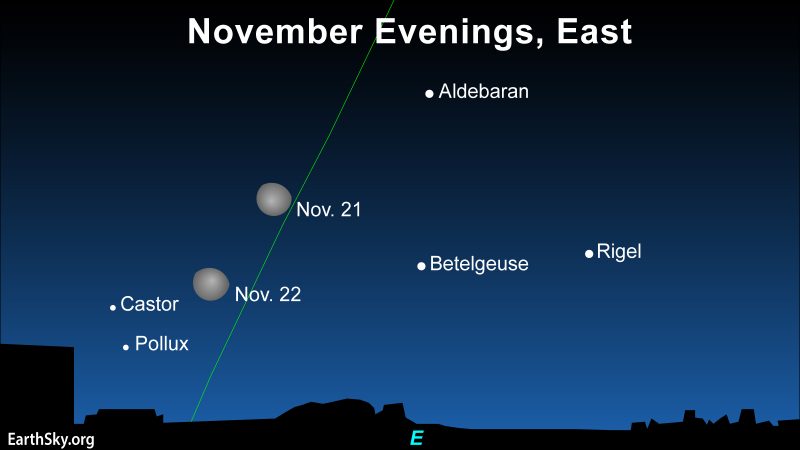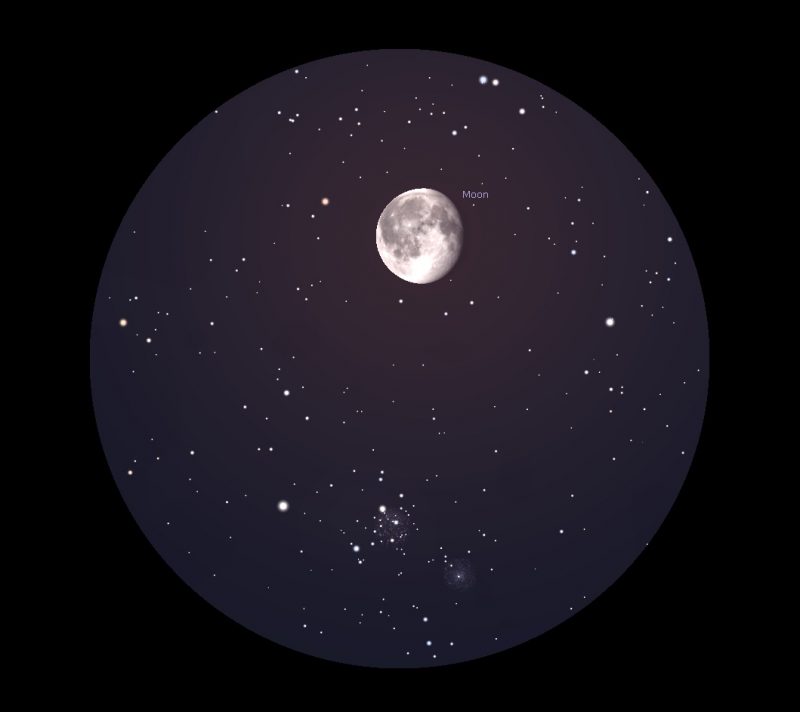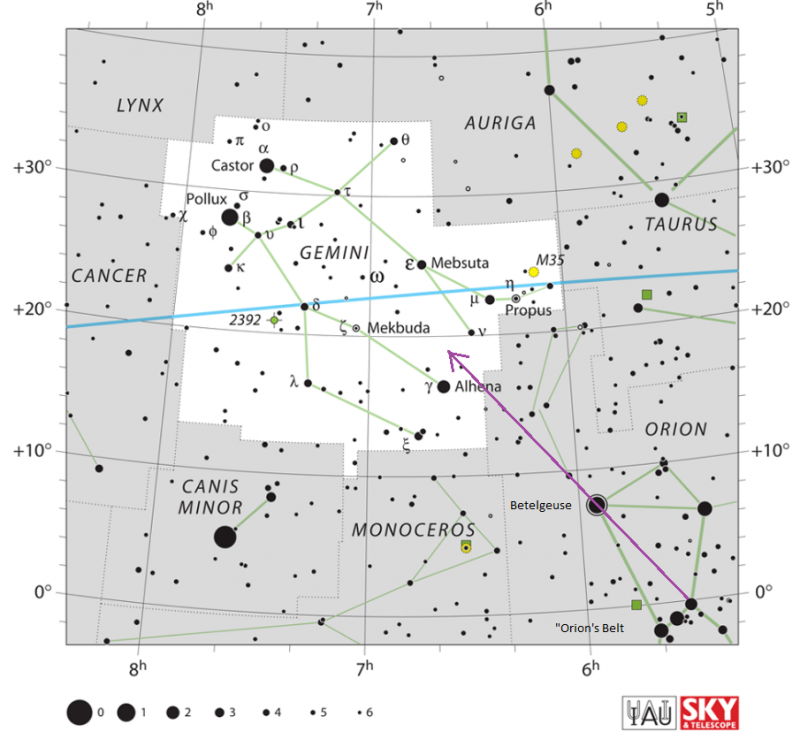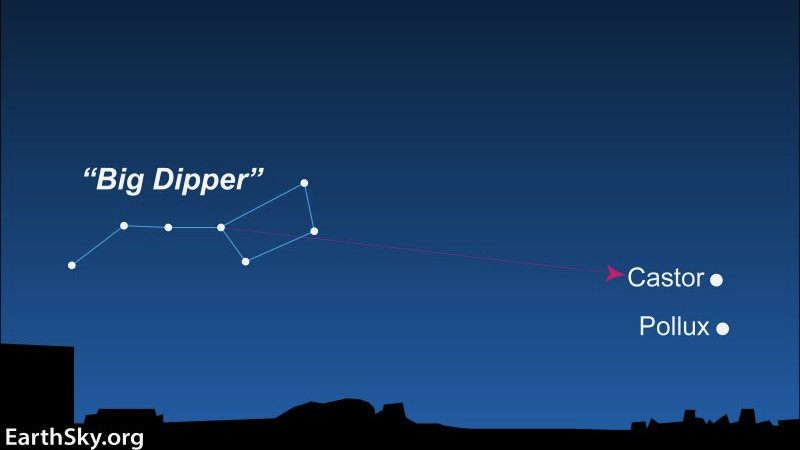
Moon in Gemini
On November 21 and 22, 2021, before going to bed, look for the moon in your eastern sky. It’ll be a bright waning gibbous moon, less than perfectly round. And you might notice two bright stars in the moon’s vicinity. They are Castor and Pollux in the constellation Gemini. These stars are noticeable for being both bright and close together on the sky’s dome. That’s why – in legends of the sky – they often represent Twins.
From mid-northern latitudes, Castor and Pollux appear over your eastern horizon with the moon by around 9 p.m. on November 21. The next evening – on November 22 – Castor and Pollux will rise about 4 minutes earlier. The moon will come up about one hour later. On November 23 after 10 p.m., Castor and Pollux will form a straight line with the moon. From the Southern Hemisphere, they all ascend in the east a bit later in the evening, after 11 p.m. If you’re not one for staying up late, you can always get up before dawn to view the moon and Gemini stars in the morning sky. Then they’ll be in the west!
The moon’s glare will make it difficult to see the entire, faint starlit figure of the Twins for the next few nights. But Castor and Pollux are bright! You’ll be able to pick them out, even when the moon is passing in front of Gemini.
For a clearer view, look again for the twin stars after about November 24, when the moon has moved on in its orbit around Earth. As it does so, it’ll be waning, or appearing less bright each evening. And it’ll be rising later, in a part of the sky not so near Castor and Pollux.
November 22 moon near M35

After the moon moves away
The constellation Orion the Hunter is just south of the moon on November 20. If you look for Orion, and come to recognize its stars, you’ll have another way of finding Castor and Pollux.
Orion is easy to see. It has many bright stars. You’ll always know you’re seeing Orion if you notice its Belt stars: three medium-bright stars in a short, straight row.
You can star-hop from Orion to Castor and Pollux. Simply draw an imaginary line from Orion’s Belt through the bright star Betelgeuse to find the Gemini stars Castor and Pollux. This way of finding Gemini’s two brightest stars works in both the Northern and Southern Hemispheres. See the chart below.
At mid-northern latitudes – like those in the mainland United States – the constellations Gemini and Orion rise at approximately the same time. However, at more northerly latitudes – like those in Alaska – Gemini rises before Orion. That far north, the Big Dipper is visible at early evening just above the northern horizon. So you can use the Big Dipper bowl to star-hop to Castor and Pollux. See the chart below.
By the way, the star Castor in the constellation Gemini very closely marks the radiant point for the Geminid meteor shower, which peaks every year around December 13 or 14.


Bottom line: The waning gibbous moon shines in the vicinity of the Gemini stars Castor and Pollux on November 21 and 22, 2021.
EarthSky astronomy kits are perfect for beginners. Order yours from the EarthSky store.
The post Moon in Gemini – near Castor and Pollux – November 21 and 22 first appeared on EarthSky.
from EarthSky https://ift.tt/3qXZCX6

Moon in Gemini
On November 21 and 22, 2021, before going to bed, look for the moon in your eastern sky. It’ll be a bright waning gibbous moon, less than perfectly round. And you might notice two bright stars in the moon’s vicinity. They are Castor and Pollux in the constellation Gemini. These stars are noticeable for being both bright and close together on the sky’s dome. That’s why – in legends of the sky – they often represent Twins.
From mid-northern latitudes, Castor and Pollux appear over your eastern horizon with the moon by around 9 p.m. on November 21. The next evening – on November 22 – Castor and Pollux will rise about 4 minutes earlier. The moon will come up about one hour later. On November 23 after 10 p.m., Castor and Pollux will form a straight line with the moon. From the Southern Hemisphere, they all ascend in the east a bit later in the evening, after 11 p.m. If you’re not one for staying up late, you can always get up before dawn to view the moon and Gemini stars in the morning sky. Then they’ll be in the west!
The moon’s glare will make it difficult to see the entire, faint starlit figure of the Twins for the next few nights. But Castor and Pollux are bright! You’ll be able to pick them out, even when the moon is passing in front of Gemini.
For a clearer view, look again for the twin stars after about November 24, when the moon has moved on in its orbit around Earth. As it does so, it’ll be waning, or appearing less bright each evening. And it’ll be rising later, in a part of the sky not so near Castor and Pollux.
November 22 moon near M35

After the moon moves away
The constellation Orion the Hunter is just south of the moon on November 20. If you look for Orion, and come to recognize its stars, you’ll have another way of finding Castor and Pollux.
Orion is easy to see. It has many bright stars. You’ll always know you’re seeing Orion if you notice its Belt stars: three medium-bright stars in a short, straight row.
You can star-hop from Orion to Castor and Pollux. Simply draw an imaginary line from Orion’s Belt through the bright star Betelgeuse to find the Gemini stars Castor and Pollux. This way of finding Gemini’s two brightest stars works in both the Northern and Southern Hemispheres. See the chart below.
At mid-northern latitudes – like those in the mainland United States – the constellations Gemini and Orion rise at approximately the same time. However, at more northerly latitudes – like those in Alaska – Gemini rises before Orion. That far north, the Big Dipper is visible at early evening just above the northern horizon. So you can use the Big Dipper bowl to star-hop to Castor and Pollux. See the chart below.
By the way, the star Castor in the constellation Gemini very closely marks the radiant point for the Geminid meteor shower, which peaks every year around December 13 or 14.


Bottom line: The waning gibbous moon shines in the vicinity of the Gemini stars Castor and Pollux on November 21 and 22, 2021.
EarthSky astronomy kits are perfect for beginners. Order yours from the EarthSky store.
The post Moon in Gemini – near Castor and Pollux – November 21 and 22 first appeared on EarthSky.
from EarthSky https://ift.tt/3qXZCX6

Aucun commentaire:
Enregistrer un commentaire